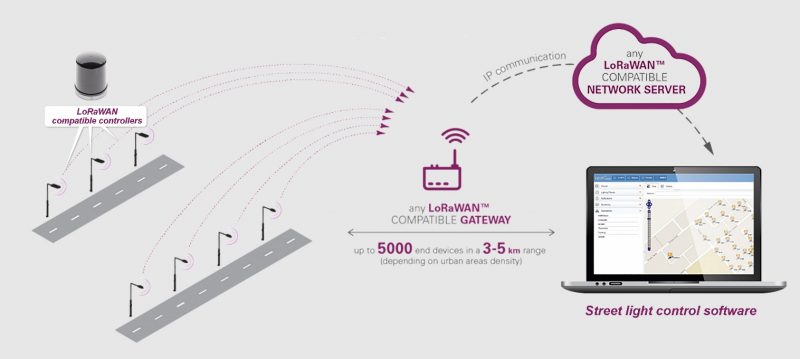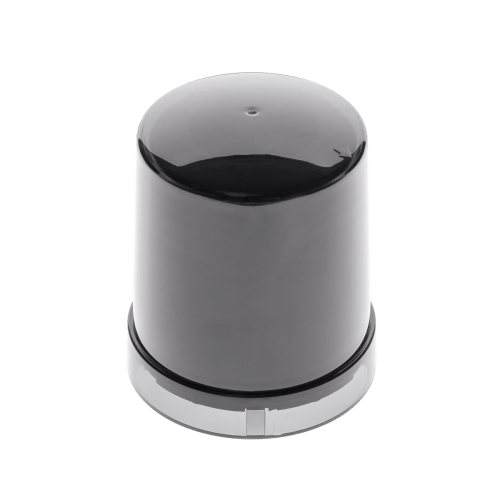The idea of using controlled lighting is becoming increasingly popular, because this saves electricity and extends the lifetime of outdoor lamps. This is made possible by the fact that LEDs are being increasingly used to illuminate various objects: from apartments to avenues. The possibility of dimming (brightness reduction) is one of the strengths of LED lighting.
To implement dimming you need a dimmer and dimmable power supply inside the lamp.
A dimmer is an electronic device that, according to specified criteria (schedule, signal from a sensor or other device, etc.) will generate a signal to control a dimmable power source. Currently, the most popular control signal protocols are the 0-10V protocol and the DALI protocol.
A dimmable power supply is, in fact, a power supply that is capable of changing the characteristics of the output power depending on the control signal received from the dimmer.
The 0-10V protocol is quite simple: a dimmer changes the voltage on the control bus in the range of 0-10V (sometimes called 1-10V). The power supply unit (driver), changes the amperage on the load power connector in proportion to this voltage. So that 2V on the control bus corresponds to 20% of the current on the power connector, 7V – 70%, etc. The advantages of this protocol include ease of implementation and low cost devices.
The DALI protocol is more complicated. All DALI devices have their logical address (the closest analogue is an IP address on the Internet) at which the dimmer can access them. It is allowed to connect 64 controlled devices to one dimmer. Moreover, all of them are connected via one bus, i.e. to control all these devices you need only two wires. This greatly simplifies and reduces the cost of on-site wiring. If it is necessary to control more than 64 devices, one more dimmer is connected and the address space is expanded by another 64 devices. There is no problem with scaling in the DALI protocol.
But all this works fine when the objects to be managed are located compactly – within the same house. And what to do if you need to control the lighting of an entire street or district and the objects are located on the territory of several square kilometers and the distances between them are hundreds of meters? Of course, it is possible to connect them with wires, but this requires serious financial expenses. It becomes obvious that it is necessary to apply one of the wireless communication technologies. For lighting control, the best choice is the LoRaWAN (Long Range Wide Area Network) technology.
Why LoRaWAN? The main features of the LoRaWAN network are low power consumption of devices and extremely wide coverage. Exactly what you need to control street lighting!
How it all works.
The client, using software, sends control commands to the LoRaWAN server. Transmission is via an IP network.
The server sends information to gateways that are installed in the area.  At this stage, the transmission of information can be performed both via the IP network as well as via GSM. One gateway can cover an area with a radius of about 2 km in urban conditions and up to 20 km in the countryside. At the same time, one gateway can support more than a thousand terminal devices – LoRaWAN controllers. The gateway broadcasts a signal for street lighting controllers – LoRaWAN dimmers, located directly on the lighting poles. Depending on the signal received, dimmers generate signals for the driver of the street LED lamp: turn on, turn off, set the desired brightness level, etc.
At this stage, the transmission of information can be performed both via the IP network as well as via GSM. One gateway can cover an area with a radius of about 2 km in urban conditions and up to 20 km in the countryside. At the same time, one gateway can support more than a thousand terminal devices – LoRaWAN controllers. The gateway broadcasts a signal for street lighting controllers – LoRaWAN dimmers, located directly on the lighting poles. Depending on the signal received, dimmers generate signals for the driver of the street LED lamp: turn on, turn off, set the desired brightness level, etc.
 At this stage, the transmission of information can be performed both via the IP network as well as via GSM. One gateway can cover an area with a radius of about 2 km in urban conditions and up to 20 km in the countryside. At the same time, one gateway can support more than a thousand terminal devices – LoRaWAN controllers. The gateway broadcasts a signal for street lighting controllers – LoRaWAN dimmers, located directly on the lighting poles. Depending on the signal received, dimmers generate signals for the driver of the street LED lamp: turn on, turn off, set the desired brightness level, etc.
At this stage, the transmission of information can be performed both via the IP network as well as via GSM. One gateway can cover an area with a radius of about 2 km in urban conditions and up to 20 km in the countryside. At the same time, one gateway can support more than a thousand terminal devices – LoRaWAN controllers. The gateway broadcasts a signal for street lighting controllers – LoRaWAN dimmers, located directly on the lighting poles. Depending on the signal received, dimmers generate signals for the driver of the street LED lamp: turn on, turn off, set the desired brightness level, etc.Company “ComLib S.R.L.” developed a street lighting control system according to this principle.
We have chosen a lamp controller, which realizes the possibility of communication using the LoRaWAN protocol.
 The device is made in a case with protection class IP-67 (full protection against dust and water) and is equipped with a NEMA-socket, which provides quick installation and connection. The device can be connected to luminaire drivers using either the 0‑10V protocol or the DALI protocol. In the latter case, it is possible not only to send data to the luminaire to control it, but also to receive data from the luminaire, such as: instantaneous power consumption, instantaneous voltage value, if the device is working, etc.
The device is made in a case with protection class IP-67 (full protection against dust and water) and is equipped with a NEMA-socket, which provides quick installation and connection. The device can be connected to luminaire drivers using either the 0‑10V protocol or the DALI protocol. In the latter case, it is possible not only to send data to the luminaire to control it, but also to receive data from the luminaire, such as: instantaneous power consumption, instantaneous voltage value, if the device is working, etc.We developed a software to work with the lighting control system. It allows you to control connected LED street lamps from anywhere in the world (turn on, turn off, dim), keep statistics on energy consumption, running time and get data on the lamp’s status. In addition, it is possible to create scenarios for the operation of lighting – dimming plans, so that you can flexibly adjust the work of luminaires to different customer needs. It does not even require any costs for the installation of additional cable lines – all control takes place via a wireless network. Moreover, due to the fact that the LoRaWAN gateway is capable of covering a large area and servicing a large number of devices, connecting new luminaires to the control system does not require any additional costs, except for the costs of the luminaires themselves and their installation.
LoRaWAN controllers allow you to build flexible smart lighting control systems that have the necessary functionality to get the most out of the lighting system and reduce the cost of maintaining it. In addition, such lighting systems are easy to scale. All this allows the use of such lighting control systems both in parking lots and parking lots of hypermarkets and shopping centers, as well as on busy motorways and city streets.
In developed countries, the installation of intelligent lighting systems for LED lamps is experiencing a real boom. And this is not surprising, because the seemingly high cost of introducing such systems pays off in a very short time – about 1.5 – 2 years by saving energy, extending lamp life time and as a result, saving on their replacement.
In addition, in European countries, huge attention is paid to the issue of reducing CO2 emissions, which is possible by reducing the level of energy consumption for street lighting when using intelligent lighting systems. Companies that pay real attention to this problem and take measures to improve the environmental situation receive a positive attitude both from citizens and various incentives from the state.
The realities of the modern world are that both companies with a reasonable approach to their costs and companies that carefully use environmental resources are ahead of its competitors. And smart lighting systems will help them in solving both issues.